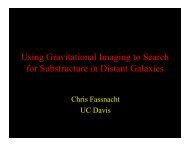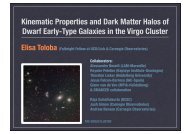DPS 42nd Meeting Abs..
DPS 42nd Meeting Abs..
DPS 42nd Meeting Abs..
- No tags were found...
You also want an ePaper? Increase the reach of your titles
YUMPU automatically turns print PDFs into web optimized ePapers that Google loves.
Presentaon Time: 10/4/2010 4:00 PM - 4:02 PMLocaon: Exhibit Hall<strong>Abs</strong>tract.<strong>Abs</strong>tract: We performed 3D calculaons of the moon of a swarm of planetesimals in a protoplanetary disk that is perturbed by a Jupiter-mass planet.The interacons between the planet and the gaseous disk and the accreon of gas on the planet were modeled through a 3D hydrodynamics code. The trajectoryof each planetesimal, in the gravitaonal field of the planet and of a solar-mass star, was determined by means of a 4th order Runge-Kua algorithm that takesinto account gas drag forces. Thermodynamics condions that may apply to a protoplanetary disk towards the end of the planet's gas accreon epoch were used.The planetesimals were inially deployed on random Keplerian orbits about the star, between 1.1 and 1.5 planet's orbital radii. The gas dynamics around theplanet was resolved on a length-scale of 0.01 planet's Hill radii (Rh). Planetesimals within a few tenths of Rh from the planet and whose velocity relave to theplanet was smaller than the escape velocity were taken as accreted. Experiments were executed with a size distribuon of an equal number of 1, 10, and 100 kmradius planetesimals. The dynamics of the smallest size planetesimals appears to be more strongly affected by gas drag forces than it is that of planetesimals oflarger sizes. However, results suggest that the accreon rates on the planet are of the same order of magnitude, once the inial surface density of planetesimalsis corrected so that all size bins contain equal masses of solids. These rates, esmated at about 5 AU, are on the order of 1e-6 sigma Earth masses per year,where sigma is the solids' surface density of a given size bin, in grams per square cenmeters, exterior of the planet's orbit. Support from NASA Origins of SolarSystems Program grants NNX08AH82G and NNX07AI72G is gratefully acknowledged.24.06: The Formaon of Uranus and Neptune in Solid-Rich Feeding Zones: Connecng Chemistry and DynamicsAuthor Block: Sarah E. Robinson 1 , P. Bodenheimer 21 University of Texas at Ausn, 2 UCO/Lick Observatory.Presentaon Time: 10/4/2010 4:02 PM - 4:04 PMLocaon: Exhibit Hall<strong>Abs</strong>tract: The core accreon theory of planet formaon has at least two fundamental problems explaining the origins of Uranus and Neptune: (1) dynamicalmes in the trans-saturnian solar nebula are so long that core growth can take >15 Myr and (2) the onset of runaway gas accreon that begins when cores reach10 Earth masses necessitates a sudden gas accreon cutoff just as Uranus and Neptune’s cores reach crical mass. Both problems may be resolved by allowingthe ice giants to migrate outward aer their formaon in solid-rich feeding zones with planetesimal surface densies well above the minimum-mass solar nebula.We present new simulaons of the formaon of Uranus and Neptune in the solid-rich disk of Dodson-Robinson et al. (2009) using the inial semimajor axisdistribuon of the Nice model, with one ice giant forming at 12 AU and the other at 15 AU. The innermost ice giant reaches its present mass aer 3.8-4.0 Myr andthe outermost aer 5.3-6 Myr, a considerable me decrease from previous one-dimensional simulaons (e.g. Pollack et al. 1996). The core masses staysubcrical, eliminang the need for a sudden gas accreon cutoff. Our calculated carbon mass fracons of 22% are in excellent agreement with the ice giantinterior models of Podolak et al. (1995). Based on the requirement that the ice giant-forming planetesimals contain >10% mass fracons of methane ice, we canreject any Solar System formaon model that inially places Uranus and Neptune inside of Saturn’s orbit. We also demonstrate that a large populaon ofplanetesimals must be present in both ice giant feeding zones throughout the lifeme of the gaseous nebula. This research marks a substanal step forward inconnecng both the dynamical and chemical aspects of planet formaon.24.07: W ITHDRAW N: Coorbital Satellite Formaon Through DisruponAuthor Block: Décio Mourão 1 , O. C. Winter 11 UNESP, Brazil.Presentaon Time: 10/4/2010 4:04 PM - 4:06 PMLocaon: Exhibit Hall<strong>Abs</strong>tract: The satellite system of Saturn is the only one known to have coorbital satellites. In general they are small bodies librang around the lagrangianpoints of a larger satellite. Dione has Helene librang around L 4 and Polideuces around L 5 . Tethys has Calipso and Telesto around L 4 and L 5 , respecvely. There isalso the pair Janus-Epimetheus with similar masses in horseshoe orbits. In these intrincated satellite systems it is also well known that there are other meanmoon resonances between Enceladus and Dione and between Mimas and Tethys. In the present study we examine the necessary condions to form coorbitalsatellite systems generated from disrupon caused by impacts during the early age of Saturn's satellite system. We considered the following scenario: A parentsatellite suffers a light collision, which remove fragments from it, generang a cloud of smaller bodies that escape from its surface. Then, a small coorbitalsatellite might be the outcome from the dynamical evoluon of the cloud of fragments, where the mutual gravitaonal interacons and even collisions are takeninto account. In this work, we simulated sets of fragments with a wide range of different mass and velocity distribuon. The first results are given in terms of thevalues of these parameters in order to get temporary coorbital systems. Then, collision and/or strong interacon between fragments were considered to removeenergy from the system in order to get permanent coorbital systems. Finaly, we found sets of adequate condions in a space of inial condions and parameters.24.08: The Formaon Environment of the Galilean MoonsAuthor Block: Neal J. Turner 1 , M. H. Lee 2 , T. Sano 31 Jet Propulsion Laboratory, California Instute of Technology, 2 University of Hong Kong, China, 3 Osaka University, Japan.Presentaon Time: 10/4/2010 4:06 PM - 4:08 PMLocaon: Exhibit Hall<strong>Abs</strong>tract: The regular satellites of the gas giant planets were formed in circumplanetary disks of gas and dust, whose evoluon was governed by mass andangular momentum transport of uncertain origins. Turbulence driven by the magneto-rotaonal instability can provide the transport if the gas is sufficientlyionised to couple to the embedded magnec fields. We compute the ionisaon states of the minimum-mass and gas-starved models of the Jovian sub-nebula,including the key effects known from Solar nebula studies: ionisaon by cosmic rays and stellar X-rays, charge transfer to metal atoms, and recombinaon ongrains.The results show that magneto-rotaonal turbulence develops in a region whose size depends on the absorbing mass column, the grain surface area, the gasphasemetal abundance and the strength of the turbulent mixing. The turbulence is almost enrely absent from the minimum-mass sub-nebula model over a widerange in these parameters. In contrast, turbulence occurs in the gas-starved model in the surface layers and throughout the parts furthest from the planet,provided sub-micron grains are underabundant.This work was carried out in part at the Jet Propulsion Laboratory, California Instute of Technology with support from the NASA Outer Planets Research program,and at the University of Hong Kong under RGC grant HKU 7024/08P.24.09: Thermally-driven Escape From An Atmosphere: Transion From Jeans To Hydrodynamic EscapeAuthor Block: Robert E. Johnson 1 , A. Volkov 1 , O. J. Tucker 1 , J. T. Erwin 11 Univ. of Virginia.Presentaon Time: 10/4/2010 4:08 PM - 4:10 PMLocaon: Exhibit Hall





